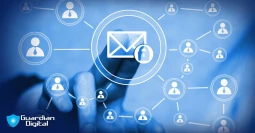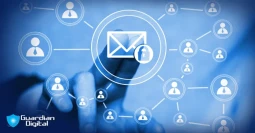How Do I Find the Location of an Email Sender in Gmail?

Our simple guide explains how to trace senders and safeguard yourself. With just a few clicks, you can reveal the source and defend yourself against potential harm. Let's begin!
Why is it important to trace an email sender's location?
Tracing an email sender's location helps identify potential security risks, verify the sender's legitimacy, and prevent fraud. Here's what is most important:
Spot Scams
Scammers often mask their identity to pilfer data. Pinpointing an email's origin can unmask these digital thieves. Verifying the sender's location offers a crucial defense against deception, and knowing how to trace the IP address of an email can be a valuable tool in identifying such scams, helping distinguish genuine messages from fraudulent ones. Learning how to track an IP address can also reveal patterns common in phishing email examples.
Stay Safe from Threats
Cyberattacks are clever and common. Checking the sender's location can verify if an email is safe. For example, an email from a local business with a foreign IP address is likely a scam. Using this strategy helps stop spam emails and serves as a basic defense against phishing attacks.
Check Business Emails
Knowing where an email comes from helps confirm its legitimacy. Businesses often receive emails from new contacts, and verifying the sender's location ensures they are genuine.
Monitor Behavior
Unusual emails need attention. Checking the sender's location can indicate safety. For instance, an email from your bank with a distant IP address is suspicious.
Fight Identity Theft
If someone is impersonating you, finding their IP address is key. This information helps authorities take action.
Handle Legal Issues
Knowing where an email comes from is vital in disputes. It can provide important context or evidence.
Boost Safety
For harassing emails, finding the IP address of an email sender is crucial. It aids in reporting to authorities and helps identify the source of the threat. You can use this information to take legal action or set up security measures to stop more incidents.
What are email headers, and how do they help trace an email's origin?
Email headers are metadata blocks attached to every email. They provide evidence of where the email traveled, including through what servers and, in some emails, through the sender's IP address. These headers have to be examined to trace where an email comes from and to check if an email is legitimate. They're essential when performing a reverse email lookup or identifying spoofing attempts.
What is an IP Address?
Like a digital fingerprint, an IP address uniquely identifies each internet-connected device. This numerical label enables tracing the origin of online communications, serving as a virtual signature for every gadget on the web.
In short, an IP address is a unique identifier for devices connected to the Internet. It helps trace the origin of an email. Understanding how to track an IP address can also help uncover sources of persistent email spoofing.
How can I view email headers in Gmail?
Follow these steps:
- Open the Email: Log in and select the email you want.
- Click the Three Dots: In the top-right corner, click the three dots (More options).
- Select “Show Original”: From the dropdown, choose “Show Original.” A new tab will open with the raw email headers.
How do I find the sender's IP address in email headers?
You can find a sender’s IP address by checking the “Received” lines in the “More Options” window:
- These lines show the email's server journey.
- You might find the sender's IP address here.
What is an SPF field, and how does it help verify an email sender?
The SPF (Sender Policy Framework) field is used to verify whether an email server is authorized to send emails on behalf of a domain. It helps prevent email spoofing by confirming the sender’s domain matches authorized servers. If the SPF check fails, the email may be fraudulent or sent from an unauthorized source.
How can I trace an IP address from an email?
If the sender's IP address is in the email headers, you can locate it online. Here's how:
- Copy the IP Address: Find and copy the sender's IP from the headers.
- Visit a GeoIP Tool: Go to IP Location or WhatIsMyIP.
- Paste the IP Address: Enter the IP address and hit Enter. The city, region, and country are linked to the IP.
Note: This works best for personal email accounts. Emails from services like Gmail or Outlook often show only the email server’s location.
What If the IP Address Is Masked?
Sometimes, an email's sender's IP address might be hidden. This can happen due to email routing or using services like VPNs. Here's what to do:
- Check the Domain: Check the sending domain (like gmail.com or yahoo.com) to verify its authenticity.
- Look for Suspicious Patterns: Many "Received" lines from odd locations may suggest a proxy or VPN.
Can I trace an email sender without an IP address?
Yes, you can use reverse email lookup services. If you can't find the IP address or want an easier option, try a reverse email lookup service. Here are some popular ones:
- EmailSherlock: It reveals the sender's location, domain history, and linked social media.
- Hunter.io: This tool verifies email senders and offers extra insights.
- Free reverse email lookup social networks: This approach helps cross-reference email identities with social accounts.
- Best reverse email lookup free: These accessible tools often deliver valuable results.
Is email tracing always accurate?
Not always. Tracing an email sender has its limits. Factors affecting accuracy include:
- Accuracy: An IP address often points to the email server, not the sender. GeoIP databases can also be inaccurate.
- Anonymity: Many use proxies or VPNs to hide their location.
- Legal and Ethical: Follow privacy laws. Only trace emails for valid reasons.
How can I protect myself from fraudulent emails?
Online safety is crucial today due to advanced cyber threats. Follow these safety measures:
- Avoid Suspicious Links: Cybercriminals hide malicious links in emails. The links might steal data or download malware. Hover before you click. If any URL is suspect or irrelevant, do not click it. Check who sent it or contact the sender directly.
- Verify the Sender: For unfamiliar emails, always check who is sending them. Check their email address carefully. Phishers tend to copy legitimate addresses but alter them by adding extra characters or misspelling them.
- Use Strong Passwords and Managers: Guard your Gmail with a fortress of letters, numbers, and symbols. Mix uppercase and lowercase characters. Steer clear of predictable choices. Birthdays and names are off-limits. Complex passwords become effortless with a password manager.
- Enable Two-Factor Authentication (2FA): 2FA adds an extra layer of security to your accounts. You’ll need a backup step to log in—think of it as a digital gatekeeper. This safeguard is essential whether it’s a code from your phone or an app.
- Keep Your Software and Devices Updated: Updates bring the latest security fixes. Hackers target outdated software. Turn on automatic updates for your system, browsers, and antivirus.
- Be Wary of Attachments: Malicious code often hides in email attachments. Unknown senders pose the greatest risk. Exercise caution with unexpected files, even from contacts. When in doubt, verify directly with the supposed sender before opening.
- Report Suspicious Emails: Click on the three dots, choose "Report phishing," and you're done. You have improved Google's spam protection and made everyone's email safer.
- Use Email Filters: Gmail lets you create filters for incoming messages. Set rules to delete, move, or label emails from suspicious senders, reducing the risk of harmful emails.
- Avoid Sharing Personal Information: Emails reveal personal data. Responsible businesses do not send emails seeking sensitive data. In case of any doubt, phone companies should check the authenticity.
- Educate Yourself on Phishing Tactics: Learn about phishing and scams. Criminals often create urgency to make you act quickly. Recognizing these tactics helps you avoid scams.
- Use a Secure Internet Connection: Avoid public Wi-Fi for Gmail. It's often insecure. If you must, use a VPN to protect your data.
- Regularly Review Account Activity: Check your Gmail activity regularly. Click "Details" at your inbox to see recent access. This helps spot unauthorized access.
- Backup Important Emails: Always back up important emails. Use cloud storage or offline tools. This saves time and stress in case of a cyberattack or deletion.
How Accurate Is Email Tracing?
Email tracing provides valuable information, but it isn't perfect. You can usually find the server or a general location, but it's rare to identify a specific address or person. However, knowing the basics helps you spot fake or questionable emails. Using email tracking tools in combination with knowledge of how to stop spam emails can boost your security even further.
Final Thoughts
Finding the source of an email's sender makes life on the web more secure. You can do so by examining email headers, using trace tools for IPs, and understanding the restraints on such. Make sure to always check regulations on privacy and use such understanding responsibly. The passage of time makes detecting where emails originate easier, and therefore, life on the web is made safer.
Other FAQs
- What Is Guardian Digital EnGarde Cloud Email Security?
- FAQs: What Are Some Examples of Malicious Code?
- How to Properly Scan Your Windows Computer for Malware & Remove Malware from Your PC
- FAQs: What Are Denial of Service (DoS) Attacks?
- FAQs: Why Outsource Businesses Email Security?
- What Is Domain Spoofing?
- What Are Insider Threats & How Can You Reduce Your Risk?
- The Silent Assassins: How Impersonation Attacks Target CEOs via Email
- How Can I Choose the Right Email Security Service for My Organization?
- What Are the Benefits of Managed Security Services Providers (MSSPs)?



